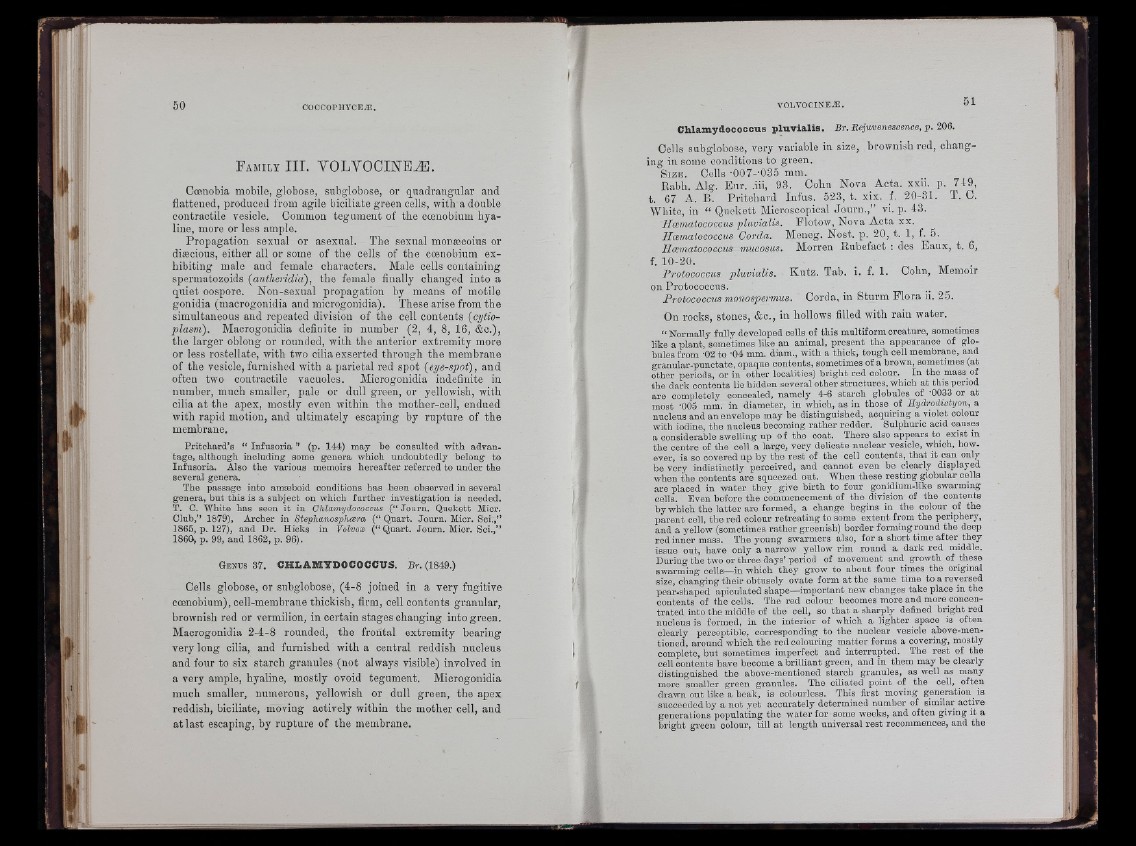
F amily I I I . V O L V O O IN B Æ .
Coenobia mobile, globose, subglobose, or quadrangular and
flattened, produced from agile biciliate green cells, with a double
contractile vesicle. Common tegument of the cænobium hyaline,
more or less ample.
Propagation sexual or asexual. The sexual monæooius or
diæcioiis, either all or some of the cells of th e cænobium exhibiting
male and female characters. Male cells containing
spermatozoids {antheridia), the female finally changed into a
quiet oospore. Non-sexual propagation by means of motile
gonidia (macrogonidia and microgonidia). These arise from the
simultaneous and repeated division of the cell contents {cytioplasm).
Macrogonidia definite in number (2, 4, 8, 16, &c.),
the larger oblong or rounded, with the anterior extremity more
or less rostellate, with two cilia exserted through the membrane
of the vesicle, furnished with a parietal red spot {eye-spot), and
often two contractile vacuoles. Microgonidia indefinite in
number, much smaller, pale or dull green, or yellowish, with
cilia at the apex, mostly even within the mother-oell, endued
with rapid motion, and ultimately escaping by rupture of the
membrane.
Pritchard’s “ Infusoria ” (p. 144) may be consulted with advantage,
although including some genera which undoubtedly belong to
Infusoria. Also the various memoirs hereafter referred to under the
several genera.
The passage into amæboid conditions has been observed in several
genera, but this is a subject on which further investigation is needed.
T. C. White has seen it in Chlamydococcus (“ Journ. Quekett Micr.
Club,” 1879), Archer in Stephanasphæra (“ Quart. Journ. Micr. Soi.,”
1865, p. 127), and Dr. Hicks in Volvote (“ Quart. Journ. Mior. Soi.,”
1860, p. 99, and 1862, p. 96).
G en u s 37. CHLAMYDOCOCCUS. Br. (1849.)
Cells globose, or subglobose, (4-8 joined in a very fugitive
cænobium), cell-membrane thiokish, firm, cell contents granular,
brownish red or vermilion, in certain stages changing into green.
Macrogonidia 2-4-8 rounded, the frontal extremity bearing
very long cilia, and furnished with a central reddish nucleus
and four to six starch granules (not always visible) involved in
a very ample, hyaline, mostly ovoid tegument. Microgonidia
much smaller, numerous, yellowish or dull green, the apex
reddish, biciliate, moving actively within the mother cell, and
at last escaping, by rupture of the membrane.
C h lam y d o co c cu s p lu v i a l i s . Br. Bejnvenesoenoe, p. 20S.
Cells subglobose, very variable in size, brownish red, changing
in some conditions to green.
Sizis. Cells •007--035 mm.
Rabh. Alg. Eur. .iii, 93. Cohn Nova Acta. xxii. p. 749,
t. 67 A. B. Pritchard Infus. 523, t. xix. f. 20-31. T. C.
White, in “ Quekett Microscopical Journ.,” vi. p. 43.
Ilæmatoeoccus pluvialis. Flotow, Nova Acta xx.
Hoematococcus Corda. Meneg. Nost. p. 20, t. 1, f. 5.
Ilæmatoeoccus mucosus. Morren Rnbefact : des Eaux, t. 6,
f. 10-20.
Protococcus pluvialis. Kutz. Tab. i. f. 1. Colin, Memoir
on Protococcus.
Protococcus monospermus. Corda, in Sturm Flora ii. 25.
On rocks, stones, &o., in hollows filled with rain water.
“ Normally fully developed cells of this multiform creature, sometimes
like a plant, sometimes like an animal, present the appearance of globules
from -02 to '04 mm. diam., with a thick, tough cell membrane, and
granular-punctate, opaque contents, sometimes of a brown, sometimes (at
other periods, or in other localities) bright red colour. In the mass of
the dark contents lie hidden several other structures, which at this period
are completely concealed, namely 4-6 starch globules of -0033 or at
most -005 mm. in diameter, in which, as in those of Hydrodictyon, a,
nucleus and an envelope may be distinguished, acquiring a violet colour
with iodine, the nucleus becoming rather redder. Sulphuric acid causes
a considerable swelling up of the coat. There also appears to exist m
the centre of the cell a large, very delicate nuclear vesicle, w'hich, however,
is so covered up by the rest of the cell contents, that it can only
be very indistinctly perceived, and cannot even be clearly displayed
when the contents are squeezed out. When these resting globular cells
are placed in water they give birth to four gonidium-like swarming
cells. Even before the commencement of the division of the contents
by which the latter are formed, a change begins in the colour of the
parent cell, the red colour retreating to some extent from the periphery,
and a yellow (sometimes rather greenish) border forming round the deep
red inner mass. The young swarmers also, for a short time after they
issue out, have only a narrow yellow rim round a dark red middle.
During the two or three days’ period of movement and growth of these
swarming cells—in which they grow to about four times the original
size, changing their obtusely ovate form at the same time to a reversed
pear-shaped apiculated shape—important new changes take place in the
contents of the cells. The red colour becomes more and more concentrated
into the middle of the cell, so that a sharply defined bright red
nucleus is formed, in the interior of which a lighter space is often
clearly perceptible, corresponding to the nuclear vesicle above-mentioned,
around which the red colouring matter forms a covering, mostly
complete, but sometimes imperfect and interrupted. The rest of the
cell contents have become a brilliant green, and in them may be clearly
distinguished the above-mentioned starch granules, as well as many
more smaller green grannies. The ciliated point of the cell, often
drawn out like a beak, is colourless. This first moving generation^ is
succeeded by a not yet accurately determined number of similar active
generations populating the water for some weeks, and often giving it a
bright green colour, till at length universal rest recommences, and the